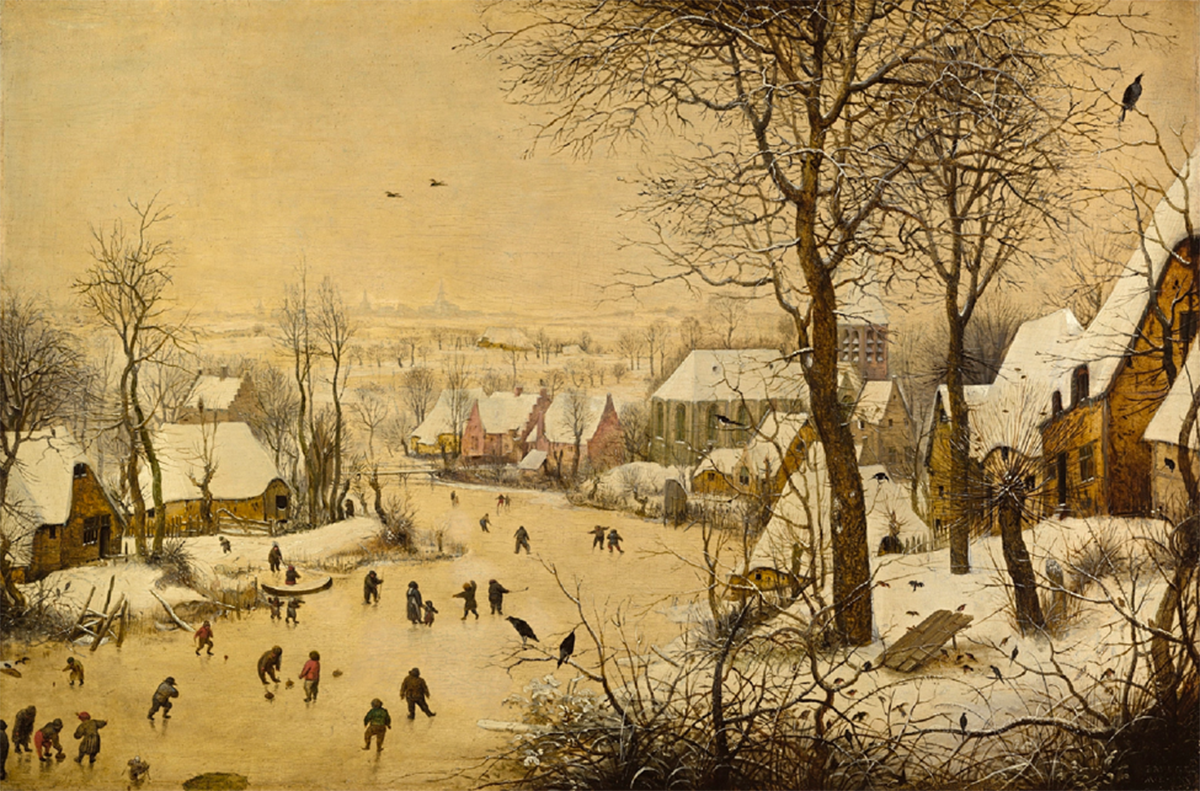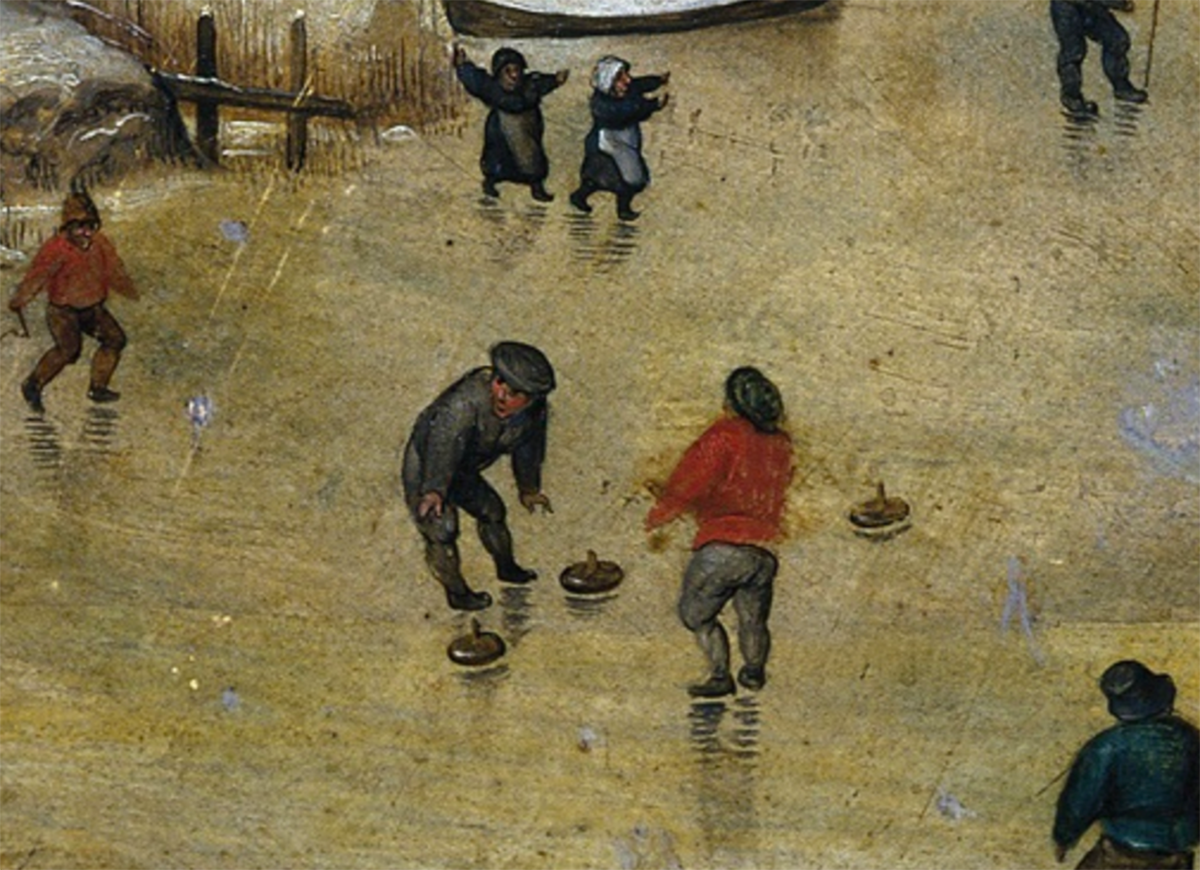44 — February 2020

Viewing a Winter Landscape
Karen Pinkus
I saw “this painting” recently in an exhibit at the Fitzwilliam Museum in Cambridge in an exhibition titled “Feast and Fast: The Art of Food in Europe, 1500-1800.” I say “this painting” but really, I should say a version of this painting, since there are dozens of copies of the original, by Pieter Bruegel the Elder, in circulation.1 Writing about “it” as a singular object is incorrect from the point of view of a collector or connoisseur or auctioneer, of course. But the curators of the exhibition must have wanted “it” not as a specific object whose value would be determined by evidence concerning its attribution, but more generically, as a visual document about how a Flemish town coped with a cold winter and set up bird traps on public land. The codes of realism recommend this work for this particular exhibit, where the painting shares space with other works of the Dutch early modern period, still lives of copious banquets, precise renderings of game and dishes and, of course, vanitas details such as peeled fruit falling over the edges of a table or reflections in a chalice – symbolic intruders on what might otherwise be “pure realism.”
To be sure, Winter Landscape(s) resonates with symbols: Birds are traditional figures of the soul and they must avoid easy temptations (like seeds scattered on the ground) or they will fall into traps set by the devil; townspeople interact in ways that cannot not reflect on moralizing proverbs that condition other works by Bruegel (father and son) and their contemporaries: life is precarious like ice and even the most sturdy may slip; and so on. Such resonances – I use this term because the symbolic in this work seems to me to bear a kind of sonic reverberation – do not undercut or foreclose the possibility that one might peer into this little world – from the perspective of a cliffside above –as a document about daily life and weather or climate or both, to the degree that they have become intertwined today. Today, scientists warn against identifying any particular event with climate change while they are more comfortable with longer term patterns (or the likelihood of a particular event occurring given higher concentrations of atmospheric carbon dioxide). And of course, they are right. Yet, when we view Winter Landscape today, in the time of climate change, we have to confront our sense of (art) history with a set of terms like “deep time,” “accelerationism,” and of course, “Anthropocene,” which mark our difference from the sixteenth century.
Winter scenes, popular in Flemish painting and best associated with the artist Henrick Avercamp (1584-1634), originate in Medieval Books of Hours, calendars referring to particular months of particular years that simultaneously illustrate daily life in broader terms. Books of Hours are both general and specific and perhaps that quality is what draws us to them in this era of disjointed temporality– and what drew me to “this painting” in the Fitzwilliam. “This painting” may be legitimately read as a document about a particularly harsh winter (1564-5). I’ve seen another work of 1565 by Pieter Bruegel the Elder, Hunters in the Snow, reproduced in a scientific textbook about climate as evidence of harsh weather during the Little Ice Age (roughly the 14th-early 19th centuries). In such a pedagogical context, it goes without saying, one would precisely not pay attention to any of the painterly details that might attract art historians or connoisseurs. To read a painting as empirical documentation “before” scientific documentation means to ignore all but its realism.

The townspeople in “the painting” – simultaneously “real” and “proverbial” – undertake activities that are “typical” because widely practiced. As scholars we also know they are “types” associated with moral sayings (even if we lack the linguistic or cultural competence to translate them precisely). If you look closely you see that these typical people are rendered by the artist(s) with a minimal number of brushstrokes. They lack detail that would render them recognizable as individuals. Their presence is verified, also, in their shadows – six or seven brushstrokes of dark paint on the ice. This painterly shorthand is completely understandable, of course, given the relative scale of the landscape. Like the birds who graze (innocent of their fate) near the trap door or perch on the branches of trees in the foreground, the townspeople are identifiable as a species, but that is as far down as the taxonomy goes. Now, when it comes to identification of bird (species) today it is often said that drawings are better tools than photographs, which, while obviously “real,” are precisely too specific. In Winter Landscape, birds and people are the equivalents of marks in an accounting ledger: pure demography.
I was thinking about what it means to view this painting today, as a document of demography and meteorology, with all of the attendant grief one might feel – call it climate trauma, solastalgia (a coinage by a philosopher, Glenn Albrecht, to refer to a sense of loss about a familiar place that one has not left; hence no nostos or return conditions the algia or pain) or simply a sense of melancholy from realizing that such frozen landscapes are becoming ever rarer. I was going to end my reflection by noting that in this moment we have begun to think about mass extinction of both humans and birds due to planetary warming (which, to be sure, involves different symptoms in different parts of the globe), and yet these peculiar forms of grief would not have been available to Bruegel the Elder or the other early modern painters who imitated him. I would have written a concluding sentence.

But several days after visiting the Fitz I was watching an episode of the popular Netflix show, The Crown, entitled “Bubbikins” (season 3, episode 4). A (fictional) anti-monarchist journalist from The Guardian is invited to interview Princess Anne, considered the most down to earth of the royals. Throughout the series the camera often pans around “Buckingham Palace” – actually a series of different palaces and sets – to showcase paintings (and indeed the Royal art collection is key to an episode featuring Soviet spy and art historian Anthony Blunt). The journalist is played by a compelling actor, Colin Morgan. By all accounts the viewer’s gaze would be fixed on him as he waits for his audience, obviously out of place and disdainful of the setting. Suddenly, though, my eye was caught by the bottom left corner of a work that hangs next to him. The scene lasts only a few seconds and we never see the entire work of art. If I had not been studying Winter Landscape I would not have made anything at all of this detail. But there it is. Or rather, there “it” is. A mere flash on the screen, one prop among hundreds of others that signify the immense wealth and power of the Windsors for the entertainment of global viewers whose algorithms will forever suggest they might also like other works about Britain, class, royalty, period pieces, and costume dramas.2 Entirely expected and inconspicuous, “this painting” (no doubt hanging in a real British palace), of which the viewer only catches a fragment for a moment, is entirely forgettable, replaceable. As precarious as the villagers and the birds they trap.
Notes
- 1 The original, a 1565 work by Pieter Bruegel the Elder is in the Royal Museum in Brussels. Some copies have been attributed to Bruegel the Younger, while still others probably date from the eighteenth century. The version in the Fitzwilliam is by Pieter Brueghel the Younger, from 1626. It is held in a private collection.
- 2 Set decoration for the series is supposed to have cost at least a hundred thousand pounds.
